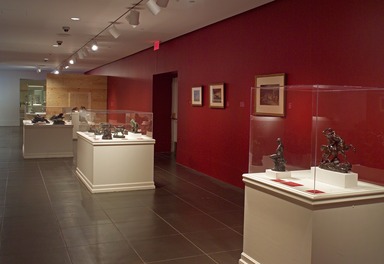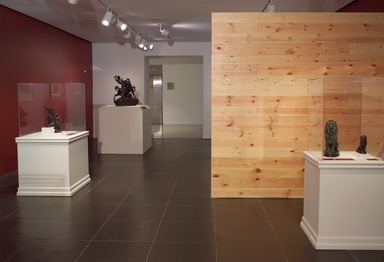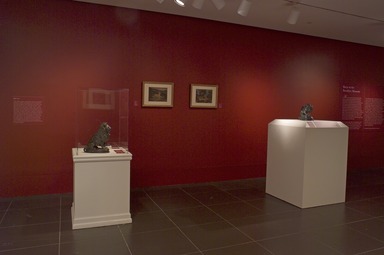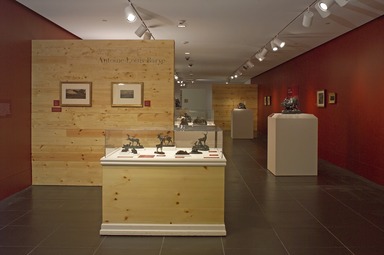

Michelangelo of the Menagerie: Bronze Works by Antoine-Louis Barye, April 29, 2005 through August 2, 2006 (Image: DIG_E_2005_Barye_01_PS2.jpg Brooklyn Museum photograph, 2005)

Michelangelo of the Menagerie: Bronze Works by Antoine-Louis Barye, April 29, 2005 through August 2, 2006 (Image: DIG_E_2005_Barye_02_PS2.jpg Brooklyn Museum photograph, 2005)

Michelangelo of the Menagerie: Bronze Works by Antoine-Louis Barye, April 29, 2005 through August 2, 2006 (Image: DIG_E_2005_Barye_03_PS2.jpg Brooklyn Museum photograph, 2005)

Michelangelo of the Menagerie: Bronze Works by Antoine-Louis Barye, April 29, 2005 through August 2, 2006 (Image: DIG_E_2005_Barye_04_PS2.jpg Brooklyn Museum photograph, 2005)

Michelangelo of the Menagerie: Bronze Works by Antoine-Louis Barye, April 29, 2005 through August 2, 2006 (Image: DIG_E_2005_Barye_05_PS2.jpg Brooklyn Museum photograph, 2005)

Michelangelo of the Menagerie: Bronze Works by Antoine-Louis Barye, April 29, 2005 through August 2, 2006 (Image: DIG_E_2005_Barye_06_PS2.jpg Brooklyn Museum photograph, 2005)

Michelangelo of the Menagerie: Bronze Works by Antoine-Louis Barye, April 29, 2005 through August 2, 2006 (Image: DIG_E_2005_Barye_07_PS2.jpg Brooklyn Museum photograph, 2005)
Michelangelo of the Menagerie: Bronze Works by Antoine-Louis Barye
-
Introduction
The French artist Antoine-Louis Barye (1795–1875) devoted his career to animal subjects: sweet groupings of woodland creatures; violent encounters between predator and prey; and mortal combats between the fantastic monsters of ancient myth. Dubbed the “Michelangelo of the Menagerie,” the artist invested his works with the character of portraiture and the dramatic intensity of battle paintings. Barye blended the Romantic taste for the exotic and the sublime power of nature with the scientific exactitude of what was at the time a burgeoning modern zoology, lending an air of accuracy to every claw, fang, and scale. In addition to a realistic physicality, Barye’s works also evoke the brays, roars, and snarls of animals as they prowl, fight, and play.
Trained as a goldsmith, Barye first utilized animal subjects as minute embellishments for functional, if sumptuous, objects. After his 1812–1814 service in the Napoleonic army, Barye studied with the neoclassical sculptor François-Joseph Bosio and the Romantic battle painter Antoine-Louis Gros. His interest in a variety of periods and styles—from the elegant austerity of classical antiquity to the florid excesses of the Baroque—was matched by an enthusiasm for in-depth observation of animals. Barye frequented menageries in and around Paris—most notably, the zoo at the Jardin des Plantes—and sketched alongside the painter Eugène Delacroix. He also attended dissections of animals at the Museum of Natural History, where he served as the Master of Zoological Drawing from 1854 until his death in 1875.
At the outset of his career, Barye submitted his works to the state-sponsored annual Salon and won acclaim in the early 1830s for plaster models of predatory scenes, including Tiger Devouring a Gavial and Lion Crushing a Serpent, bronze casts of which are displayed in this exhibition. This success brought princely private commissions from the house of Orléans as well as prestigious public ones from the state. After this early splash, however, Barye’s critical fortunes were mixed: although avant-garde writers allied with Romanticism praised the development of these exciting new works for their verve and drama, traditionalists lamented their lack of overt educational or moral value. Modern scholars have suggested that the violence in Barye’s scenes reflects the bloody Napoleonic wars and the turbulence of the French political scene at the time.
Barye earned both personal and professional distinctions throughout his career, including awards of the Légion d’honneur, prestigious teaching and curatorial appointments at the Louvre, and election to the Institut de France. In 1875, he was buried at Père Lachaise, an honor reserved for the French elite. -
Barye at the Brooklyn Museum
After the exclusive state-sponsored Salon rejected an important submission in 1837, Barye concentrated on the fabrication of small bronze works for the commercial market. He established his own foundry, published a catalogue of his bronzes, and refined casting techniques significantly, which earned him additional accolades. Barye’s relatively large-scale serial production of affordable bronzes popularized his work in both Europe and the United States. American heirs to this artistic legacy include the sculptors Robert Rockwell and Alexander Phimister Proctor, whose animal subjects are on view in the Luce Center for American Art’s Visible Storage · Study Center, located on the fifth floor.
Barye’s modestly sized table- and mantle-top works introduced a note of the exotic and the untamed into staid ninteenth-century domestic interiors, and his sporting or hunt scenes likely appealed to the aristocratic aspirations of the upwardly mobile.
The wealthy American investment banker Cyrus J. Lawrence (1832–1908) acquired the vast majority of the works now included in the Brooklyn Museum’s collections. Lawrence was such an avid admirer of the artist that he and several prominent Americans—most notably, William T. Walters and William Corcoran, founders of museums in Baltimore and Washington, D.C., respectively—established a fund to erect a monument to Barye in Paris. The memorial, completed in 1894, included versions of Barye’s best known works, such as Lion Crushing a Serpent and Theseus Combatting the Centaur Biénor, bronze casts of which are also displayed in this exhibition. The Brooklyn Museum acquired the entirety of Lawrence’s collection of Barye bronzes and watercolors in 1910 with funds donated by the public. The labels provided for the works in this gallery list the dates of the original models created by Barye. Cast dates for these bronzes are unknown.
-
February 8, 2005
Michelangelo of the Menagerie: Bronze Works by Antoine-Louis Barye features approximately seventy works from the Brooklyn Museum’s holdings of bronzes and watercolors by the French artist Antoine-Louis Barye (1795–1875), one of the foremost nineteenth-century animalier sculptors. The exhibition will be on view from April 29 through July 24, 2005, in the Museum’s second-floor Mezzanine Gallery.
Dubbed the “Michelangelo of the Menagerie” by the contemporaneous art critic Théophile Gautier, Barye devoted his career to animal subjects, from sweet groupings of woodland creatures to violent encounters between predator and prey to mortal combats between the fantastic monsters of ancient myths. He blended the romantic taste for the exotic and the sublime power of nature with the scientific exactitude of a flourishing modern zoology, lending an air of accuracy to every claw, fang, and scale.
Trained as a goldsmith, Barye began his career working on animal subjects as minute embellishments for functional, if sumptuous, decorative objects. After military service in the Napoleonic army, he began formal studies in the fine arts. Throughout his life, Barye frequented menageries in and around Paris—most notably, the zoo at the Jardin des Plantes. He also attended dissections of animals at the Museum of Natural History, where he served as the Master of Zoological Drawing from 1854 until his death.
At the outset of his career, Barye submitted works to the state-sponsored annual Salon and won raves in the early 1830s for plaster models of his predatory scenes, including Tiger Devouring a Gavial (1831) and Lion Crushing a Serpent (1833)—works included in this exhibition as bronze casts. This success brought princely private commissions from the house of Orléans and prestigious public ones from the state. After his early success, Barye’s critical fortunes were mixed: avant-garde writers praised his sculptures, which challenged the hierarchy of the genre with their monumentality and verve, while traditionalists lamented the lack of overt educational or moral value in his work. Scholars have since suggested that the violence in Barye’s scenes is evocative of the bloody napoleonic wars and the turbulence of the French political scene.
After a refusal from the Salon in the late 1830s, Barye concentrated on the fabrication of small bronze works for a broader commercial market. This relatively large-scale serial production of affordable bronzes popularized Barye’s work in both Europe and the United States. The wealthy American investment banker Cyrus J. Lawrence collected the vast majority of the works displayed in this exhibition. At his death, the entirety of Lawrence’s collection of Barye bronzes and watercolors was auctioned in 1910 and acquired as a set by the Brooklyn Museum with funds donated as part of a special subscription.
This exhibition is being organized by Judith F. Dolkart, Assistant Curator, Department of European Painting and Sculpture.
View Original





















